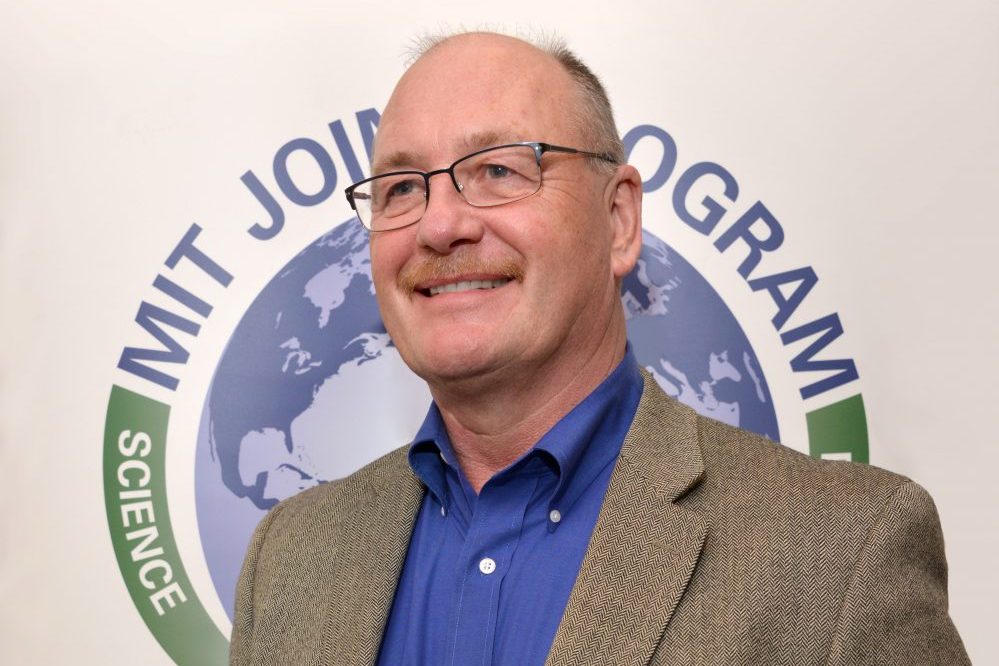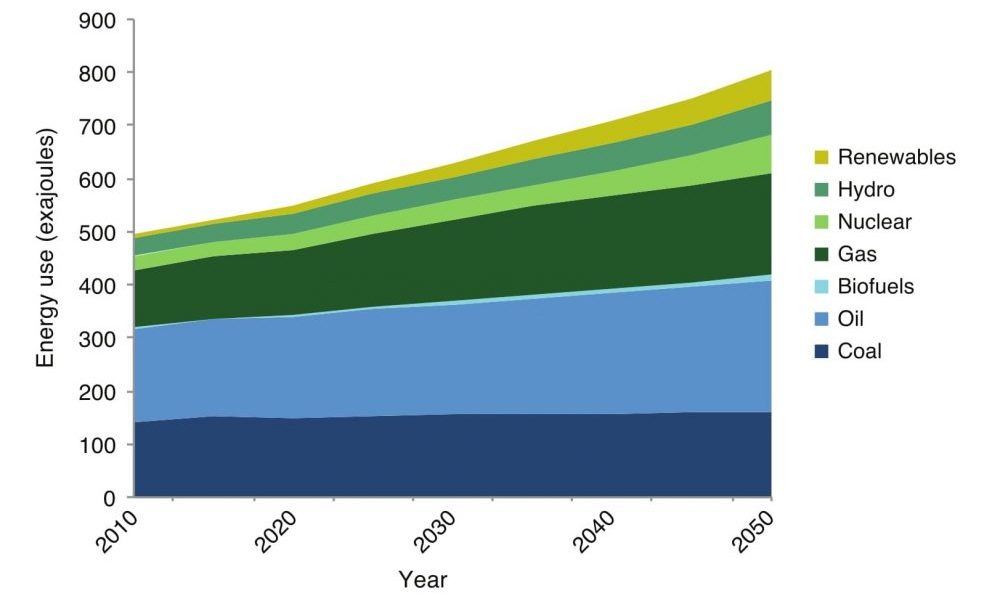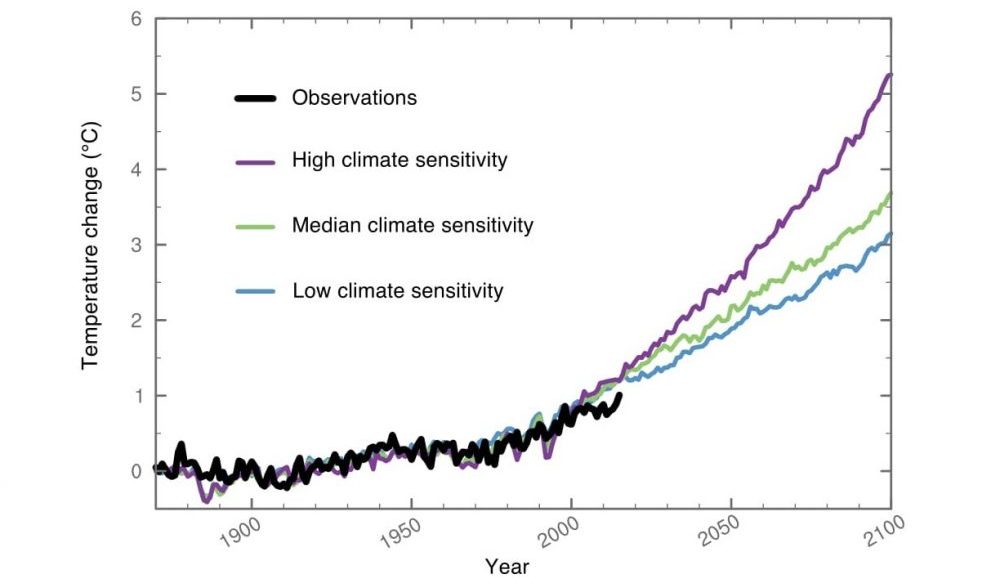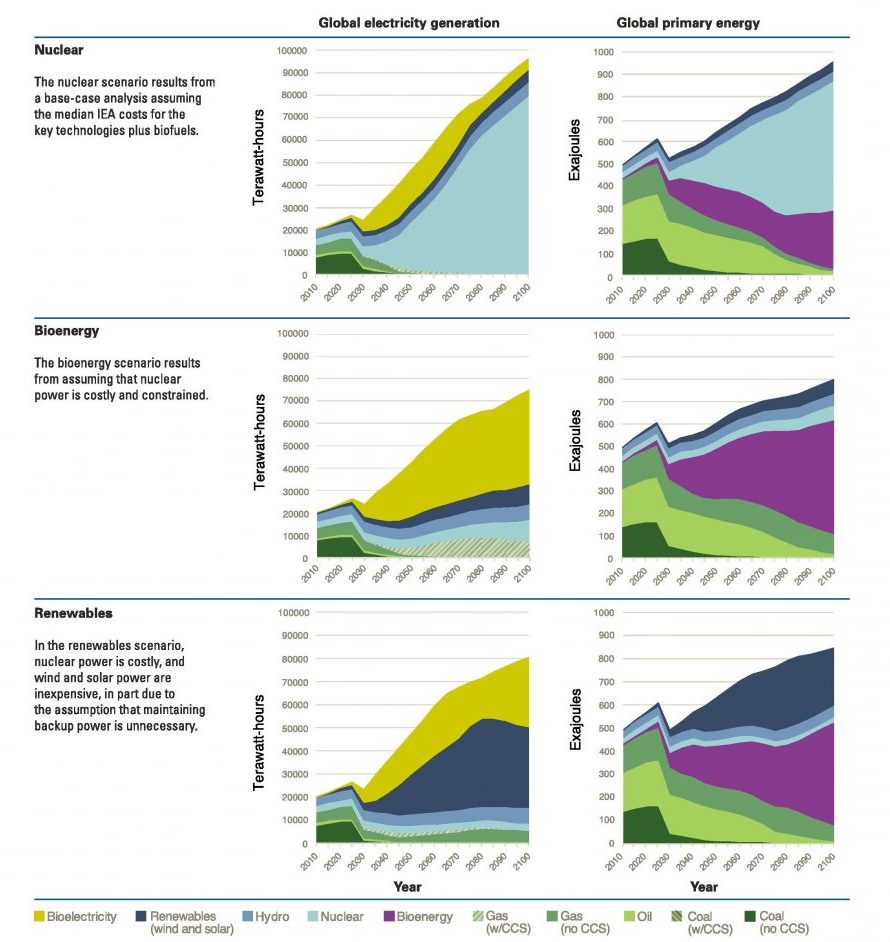
An MIT analysis of the Paris climate agreement finds that—even if all the participating nations meet their pledges—global warming will exceed the 2°C maximum targeted for 2100 as early as 2050. To determine what else is needed, researchers at the MIT Joint Program on the Science and Policy of Global Change calculated a series of global energy technology mixes that would meet future demand while generating greenhouse gas emissions consistent with the 2°C target. Depending on the assumed costs plus a uniform global carbon price, different technologies dominate, but all the successful combinations are markedly different from today’s global energy system. The researchers conclude that substantial R&D investment is needed to lower the cost of key energy technologies and help transform the global energy system—a shift that must be well under way within the next decade or so if the world is to meet its targets.
At the Paris climate talks in late 2015, almost 200 nations signed an agreement designed to limit warming at the Earth’s surface to 2°C or less above preindustrial levels—a long reiterated target intended to avert some of the worst consequences of climate change. But are the nations’ individual “Intended Nationally Determined Contributions” (INDCs) pledged under the agreement aggressive enough to put the world on a path to meet the climate target? If not, what will the outcome be, and what other measures may be needed to get us there?
Those questions and more are addressed in 2016 Food, Water, Energy, and Climate Outlook, the latest in a series of reports published annually since 2012 by the MIT Joint Program on the Science and Policy of Global Change to provide updates on the direction the planet is heading in terms of economic growth and implications for resource use and the environment. New this year is an examination of agricultural and water resource challenges as well as perspectives from experts in the Joint Program, the MIT Energy Initiative, BP, and the Energy Innovation Reform Project on technical and economic barriers and hoped-for breakthroughs in key technologies associated with providing energy and electricity.
The Paris scenario and a risky future
The researchers’ first task was to assess the effectiveness of the pledges made in the Paris Agreement. How will they affect the future mix of energy technologies and fuels, what will be the impact on emissions, and what effect will those emissions have on global temperatures?
The team addressed those questions using the Integrated Global System Model (IGSM), a linked set of computer models developed by the Joint Program to analyze interactions among human and Earth systems. The Economic Policy and Projection Analysis component simulates world economic growth as a result of population, productivity, and energy technology choices based on their costs. The MIT Earth System Model simulates chemical reactions in the atmosphere, climate dynamics, and changes in natural ecosystems, including vegetation, soils, and the oceans. Under the IGSM framework, the two models interact to project global environmental changes that may arise from human activities and the impacts of proposed policy measures on those changes.
To examine the impact of the Paris Agreement, the researchers ran the IGSM using future population and economic growth estimates based on data from the United Nations, the International Monetary Fund, and other sources. They introduced policies and measures that they believe reflect the INDCs of the major emitting nations and assumed that all participants would adhere to their pledges through 2025 (and beyond) and that no further measures would be enacted.
Global primary energy use under the Paris Agreement

This chart shows projected energy use worldwide by energy source. The calculations are based on population forecasts from the United Nations and economic growth estimates from the International Monetary Fund, and they assume that policies and measures under the Paris Agreement remain in effect through 2050 (and 2100) but without deeper cuts or broadening participation by more countries. Renewables and nuclear grow, but the world energy mix continues to be dominated by fossil fuels.
The figure above shows the resulting distribution of energy use by different sources between 2010 and 2050. The forecast brings some (seemingly) encouraging news: There’s an eight-fold increase in renewables and a three-fold increase in nuclear power. “But both start out as small fractions of the total, so that growth isn’t enough to drive out fossil fuels,” says John Reilly, co-director of the Joint Program and senior lecturer in the MIT Sloan School of Management. The fossil energy share shrinks from 86% today to 75% by 2050, but the world remains largely fossil-fuel dominated—and in 2100, fossil fuels still claim 58% of the total.
The researchers next calculated the global emissions that would result from that projected energy mix. They accounted for emissions of all types of greenhouse gases (GHGs) from all human sources, including energy, industry, agriculture, waste, and changes in land use. Their results show that total emissions in 2100 are more than 60% higher than they were in 2010, and two-thirds of that total consists of carbon dioxide (CO2) emitted by fossil fuels.
Finally, based on that emissions outlook, they estimated changes in the global surface air temperature from preindustrial levels. The response of the Earth system to radiative forcing by GHGs is uncertain. As a result, analyses of a given GHG concentration can produce a range of projected temperature increases, some more likely than others. To reflect that uncertainty, the researchers performed separate analyses assuming that the global climate exhibits low, median, or high sensitivity to the presence of atmospheric GHGs. The results appear in the three curves in the figure below. By 2050, the projected temperature rise—depending on the assumed sensitivity—ranges from 1.9°C to 2.6°C, and by 2100, the range is 3.1°C to 5.2°C.
Change in global mean temperature from preindustrial levels

These curves show MIT estimates of changes in temperature since 1870 (defined as the preindustrial level), assuming that the global climate exhibits low, median, and high sensitivity to atmospheric greenhouse gases. Temperature change is calculated based on the primary energy mix that results from the policies and measures of the Paris Agreement, assuming that they remain in effect through 2100 without deeper cuts or broadening participation by more countries. The 2°C target for 2100 is exceeded as early as 2050.
Calculations of the associated impacts on food and water produce equally alarming forecasts. Even if all the pledges in the Paris Agreement are carried out, significant risks still remain for staple crops in major “breadbasket” regions of the world and for water supplies on which most of the global population depends.
“So even if we’re lucky and the Earth is not very responsive to GHG forcing, by 2050 we’re within a tenth of a degree of the 2°C target,” says Reilly. “We’re obviously not anywhere close to meeting it, and given the risks involved, it’s prudent to pursue more aggressive policies to stabilize climate.”
Emissions and energy scenarios for the 2°C pathway
The researchers next developed emissions scenarios that would successfully keep the temperature increase at or below the targeted level. The analyses assume that the Paris Agreement locks in behavior through 2025, and then in 2025 a globally uniform, rising carbon price is introduced with the starting value set so as to limit cumulative emissions as needed by 2100.
The figure below shows the results for CO2 emissions. The top curve is a reference case reflecting emissions in the absence of the Paris pledges. The other three curves show how much emissions must drop to meet the 2°C target, assuming the three levels of sensitivity. Not surprisingly, the higher the climate sensitivity, the lower the required emissions path. More striking is the abrupt drop between 2025 and 2030. The median case requires a 31% reduction in emissions in those five years. The high-sensitivity case requires that emissions be cut in half.
Emissions paths for 2°C warming

This chart shows calculated CO2 emissions trajectories that would limit warming to below 2°C in 2100, assuming low, median, and high climate sensitivity. The Paris Agreement is in effect through 2025, after which a carbon price is imposed to limit cumulative emissions as needed to meet the 2100 target. The abrupt drop between 2025 and 2030 confirms that the Paris pledges alone are not sufficiently aggressive to produce a path consistent with climate stabilization.
Despite the high cost and disruption of making such an abrupt correction, the model suggests that it would be economically optimal to do so. Reilly offers an analogy. “If you’re speeding along and suddenly realize there’s a cliff in front of you, you’re going to crank the wheel pretty hard, even if it throws people around the back seat,” he says. “If we continue on our current course and suddenly recognize that we really have to meet the 2°C target, we’ll need to crank the wheel suddenly on our world energy system, regardless of the costs.”
Energy mixes that would work
While drastic changes in the global energy mix are needed, there are various combinations of technologies that could work. To illustrate, the researchers examined a series of scenarios in which—by virtue of assumed costs and other constraints—certain technologies dominate in a future energy mix that meets the target. Results from three of the analyses are shown in the charts below. (All of the analyses assume median climate sensitivity and International Energy Agency [IEA] estimates of technology costs, except where noted.)
Energy mixes to meet the 2°C challenge

The charts above show three sets of electricity generation and primary energy mixes designed to meet the 2°C target for 2100. They result from analyses in which the researchers assumed a rising carbon price along with costs and constraints such that selected technologies play the dominant role. A fourth analysis assuming inexpensive carbon capture and sequestration (CCS) produces results almost identical to the bioenergy scenario.
Nuclear dominance
To establish a base case, the researchers assumed median IEA costs for all the key energy technologies plus biofuels. The outcome is a world in which nuclear energy rapidly becomes the dominant source of electricity. Bioelectricity plays a minor role, along with hydropower and renewables where they easily integrate into the system.
Nuclear likewise dominates the primary energy outcome. Bioenergy also plays a growing role, with some going to electricity production but much of it into liquid fuels for vehicles. (No breakthroughs in electric vehicles were considered.) Coal disappears quickly, while oil and gas decline more slowly over time. Fossil fuels’ share of global energy falls to 38% by 2050 and 3% by 2100.
A biomass world
A significant global expansion of nuclear energy could prove difficult, given political and other concerns, so the researchers also performed an analysis in which the nuclear option is costly and limited by other constraints. When the cheap nuclear option is taken away, energy conservation and efficiency increase, and total electricity and energy consumption drop.
Bioenergy now dominates the electricity sector, with some help from natural gas with carbon capture and sequestration (CCS) as well as renewables, hydro, and nuclear. Bioenergy is likewise an important source of primary fuel—both for generating electricity and for replacing oil products for transportation.
Renewables rule
For wind and solar to play a dominant role, the researchers had to assume that the intermittency problem would be solved by inexpensive energy storage or advances in grid operation. Otherwise, the cost of maintaining backup capacity—for example, gas turbines or bioelectricity plants—makes the large-scale penetration of renewables economically infeasible.
Given low-cost solar and wind and constrained nuclear, renewables make up about half of all electricity generation, with another chunk coming from bioelectricity. Renewables also play a major role in primary energy, exceeded only by bioenergy, which is used for both electricity generation and liquid transportation fuels.
Carbon capture and sequestration
In another analysis (not shown in the figure), the researchers constrained nuclear energy and dropped the cost of CCS to the low end of the IEA range. Interestingly, the results for electricity generation and primary energy are almost identical to those in the bioenergy case. Even at the low end of the cost estimates, CCS is too expensive to compete. Part of the problem is that the CCS technology captures at most 90% of the emissions, and the carbon price must be paid on the emissions that remain.
Other options and the path forward
The analyses presented in the report don’t look at adding CCS to biomass electricity generation—a combination that Reilly considers a kind of magic formula. “You grow the trees, which takes carbon out of the atmosphere,” he says. “Then you burn the trees, which releases carbon, but you suck that carbon out of the power plant and put it underground. You get a net-negative.” With that arrangement, a power plant would jointly produce carbon reductions and electricity— and would get paid for both. In that scenario, emissions could go to zero or below over the long term, Reilly says.
Reilly stresses the importance of reaching zero emissions. “People think that if emissions stop rising, then we’ll have achieved stabilization—but they’ll still be building up in the atmosphere,” he says. “What we need to remember is that to stabilize concentrations of CO2 in the atmosphere, we have to get to virtually no CO2 emissions.” And given continuing GHG emissions from livestock, fertilizers, and other critical sources, achieving negative CO2 emissions somewhere will be needed to get to net zero emissions.
The researchers conclude that the transition to a dramatically different global energy mix must be well under way within the next 10 to 20 years to prevent an excessive temperature increase by 2100. They recognize that such an undertaking will almost certainly require extraordinary political agreement or sudden and unforeseen breakthroughs in technology. They assert that since it’s not clear which technologies will take the lead, substantial R&D investment is needed to develop current technologies, explore new ones, and increase the efficiency with which we use energy so less is required in the future. The technological advances and cost reductions that result will help countries move forward on climate change and support the transition onto a 2°C energy pathway as soon as possible.
This research was supported by the MIT Joint Program on the Science and Policy of Global Change and its international partnership of government, industry, and foundation sponsors and private donors. Other contributors include the MIT Energy Initiative (MITEI); the Energy Innovation Reform Project; and BP, a Founding Member of MITEI.
Further information can be found in:
MIT Joint Program on the Science and Policy of Global Change. 2016 Food, Water, Energy, and Climate Outlook. Download the report.
This article appears in the Spring 2017 issue of Energy Futures.